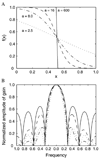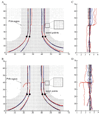An image-processing toolset for diffusion tensor tractography
- PMID: 17371726
- PMCID: PMC2719760
- DOI: 10.1016/j.mri.2006.10.006
An image-processing toolset for diffusion tensor tractography
Abstract
Diffusion tensor imaging (DTI)-based fiber tractography holds great promise in delineating neuronal fiber tracts and, hence, providing connectivity maps of the neural networks in the human brain. An array of image-processing techniques has to be developed to turn DTI tractography into a practically useful tool. To this end, we have developed a suite of image-processing tools for fiber tractography with improved reliability. This article summarizes the main technical developments we have made to date, which include anisotropic smoothing, anisotropic interpolation, Bayesian fiber tracking and automatic fiber bundling. A primary focus of these techniques is the robustness to noise and partial volume averaging, the two major hurdles to reliable fiber tractography. Performance of these techniques has been comprehensively examined with simulated and in vivo DTI data, demonstrating improvements in the robustness and reliability of DTI tractography.
Figures












Similar articles
-
An improved Bayesian tensor regularization and sampling algorithm to track neuronal fiber pathways in the language circuit.Med Phys. 2010 Aug;37(8):4274-87. doi: 10.1118/1.3456113. Med Phys. 2010. PMID: 20879588 Free PMC article.
-
A tractography comparison between turboprop and spin-echo echo-planar diffusion tensor imaging.Neuroimage. 2008 Oct 1;42(4):1451-62. doi: 10.1016/j.neuroimage.2008.05.066. Epub 2008 Jun 21. Neuroimage. 2008. PMID: 18621131 Free PMC article.
-
The effect and reproducibility of different clinical DTI gradient sets on small world brain connectivity measures.Neuroimage. 2010 Jul 1;51(3):1106-16. doi: 10.1016/j.neuroimage.2010.03.011. Epub 2010 Mar 11. Neuroimage. 2010. PMID: 20226864
-
Diffusion tensor MR imaging and fiber tractography: technical considerations.AJNR Am J Neuroradiol. 2008 May;29(5):843-52. doi: 10.3174/ajnr.A1052. Epub 2008 Mar 13. AJNR Am J Neuroradiol. 2008. PMID: 18339719 Free PMC article. Review.
-
Using diffusion imaging to study human connectional anatomy.Annu Rev Neurosci. 2009;32:75-94. doi: 10.1146/annurev.neuro.051508.135735. Annu Rev Neurosci. 2009. PMID: 19400718 Review.
Cited by
-
Diffusion tensor imaging and tractwise fractional anisotropy statistics: quantitative analysis in white matter pathology.Biomed Eng Online. 2007 Nov 9;6:42. doi: 10.1186/1475-925X-6-42. Biomed Eng Online. 2007. PMID: 17996104 Free PMC article.
-
In vivo study of cerebral white matter in the dog using diffusion tensor tractography.Vet Radiol Ultrasound. 2015 Mar-Apr;56(2):188-95. doi: 10.1111/vru.12211. Epub 2014 Oct 6. Vet Radiol Ultrasound. 2015. PMID: 25288360 Free PMC article.
-
Three-dimensional interactive and stereotactic human brain atlas of white matter tracts.Neuroinformatics. 2012 Jan;10(1):33-55. doi: 10.1007/s12021-011-9118-x. Neuroinformatics. 2012. PMID: 21505883
References
-
- Le Bihan D. Looking into the functional architecture of the brain with diffusion MRI. Nat Rev Neurosci. 2003;4:469–480. - PubMed
-
- Jones DK, Lythgoe D, Horsfield MA, Simmons A, Williams SC, Markus HS. Characterization of white matter damage in ischemic leukoaraiosis with diffusion tensor MRI. Stroke. 1999;30(2):393–397. - PubMed
-
- Horsfield MA, Larsson HB, Jones DK, Gass A. Diffusion magnetic resonance imaging in multiple sclerosis. J Neurol Neurosurg Psychiatry. 1998;64 Suppl 1:S80–S84. [Review] - PubMed
-
- Bastin ME, Delgado M, Whittle IR, Cannon J, Wardlaw JM. The use of diffusion tensor imaging in quantifying the effect of dexamethasone on brain tumours. Neuroreport. 1999;10(7):1385–1391. - PubMed
Publication types
MeSH terms
Grants and funding
LinkOut - more resources
Full Text Sources

